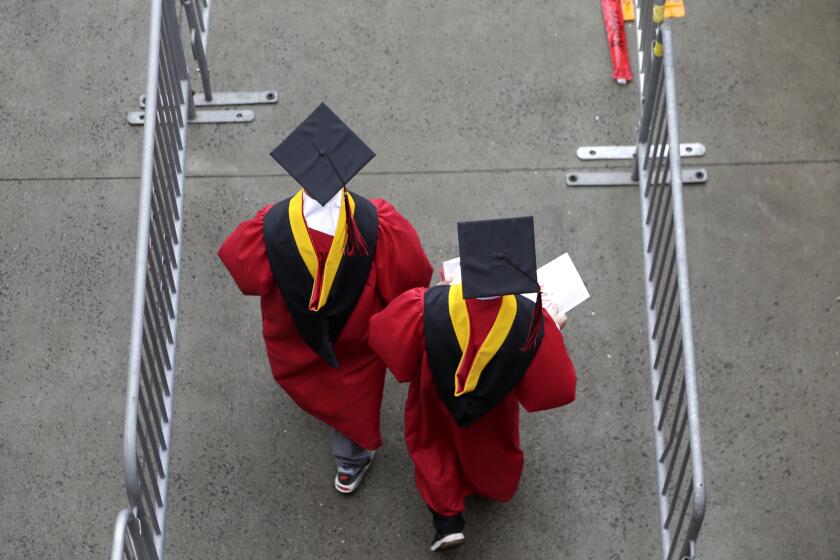Editorial: To thrive, people need space to breathe, walk and play. Vote yes on Measure A for parks
Los Angeles County Measure A would impose a tax on improved property, at a rate of 1.5 cents per square foot, to pay for parks, recreation, open space and cultural amenities. It would replace a county tax that passed in 1992 but expired last year, and another one adopted in 1996 that sunsets in two years. Those taxes have been the primary source of parks funding not just in the county’s system but for most of the region’s 88 cities as well.
Measure A brings its share of controversies, as all tax measures do, but it is carefully crafted and a responsible successor to the expired and expiring taxes. The Times urges voters to say yes.
The first and obvious question about Measure A is why a tax for parks and other assets is needed in the first place, if those are basic services of local government that ought to be paid out of their general-fund budgets. The short answer is that those budgets and the property taxes that fund them are exhausted by the cost of basic services like police and fire protection. For decades, voters have agreed to special taxes to maintain and expand quality-of-life services such as libraries, museums — and parks.
In Los Angeles County, there can be no question as to the value of such assets or the need to maintain them. As the region’s population grows, open space is one of the things that makes life here not only bearable but enviable. Much of what is iconic about L.A., from the Malibu sand to the Hollywood Hills to the high desert to the San Gabriel Mountains, includes parks and trails — and parking, restrooms, scenic overlooks, instructional space and recreational facilities — that were built, and now are maintained and kept accessible, by county parks taxes.
Despite all that open space, though, huge swaths of Los Angeles County remain park poor. In preparing for this ballot measure, county supervisors commissioned a wide-ranging and intensive study that exposed how severely millions of residents are deprived of neighborhood parks and recreational amenities such as pools, basketball courts, swing-sets and gyms. Parks are further out of easy reach in parts of this county than in comparable urban areas around the nation.
That’s not merely a quality-of-life concern, but a health problem as well. To thrive, people need to be able to move — to walk, to play, to swim, to run. Children need places to do all those things early enough in life that they will get into the habit.
A series of public hearings on parks, including several meetings of the Board of Supervisors, exposed some tension between differing views and positions about the need for parks in Los Angeles.
“You have more than enough,” many members of poorer communities essentially told open-space advocates. “It’s time for parks money to come to us.”
“We have the great recreational spaces,” was one answer. “Instead of wasting money on tiny pocket parks in crammed neighborhoods, we should expand the existing open space and encourage the have-nots to come visit.” And then, presumably, go home.
The drafters of Measure A did a pretty good job of designing a program under which chunks of funding are distributed equitably, by need, geography and interest. Importantly, much of the funding will be made in the form of grants to cities and other applicants that can present a good case for their projects. That will allow the funding system to keep up with demographic and other changes that affect park needs.
They also did a far better job involving the public than the county did two years ago, when voters rejected a parks ballot measure (Proposition P) that the Board of Supervisors had offered with no meaningful opportunity for public input. Nevertheless, some business groups say they weren’t consulted on one key element of the new plan: replacing the earlier proposal’s flat $23 charge per parcel with a per-square-foot levy, which they say would be unfair to businesses that own large buildings such as warehouses or superstores.
That was indeed a flaw in the process, but not a fatal one. The ongoing talks about a new parks measure after the defeat of Proposition P were not a mystery to business groups.
In addition, the county’s move away from a flat per-parcel tax is a good one. It hardly seems equitable for the owner of an eighth-acre lot to pay the same as the owner of a multiacre parcel. It might be better still to impose the tax based on the value of the property, but such taxes are capped under Proposition 13 and cannot be supplemented for parks or anything else. Nor can the county impose a benefits assessment as it did with the expiring tax because of an additional tax restriction adopted in 1996.
With those methods off the table, a 1.5-cent tax on built square-footage is the fairest option. Measure A would be good for the county, its people and its quality of life. It deserves a “yes” vote.
Follow the Opinion section on Twitter @latimesopinion and Facebook
More to Read
A cure for the common opinion
Get thought-provoking perspectives with our weekly newsletter.
You may occasionally receive promotional content from the Los Angeles Times.










